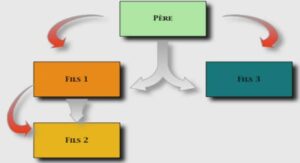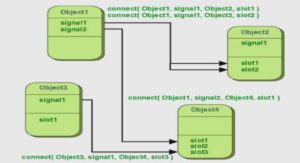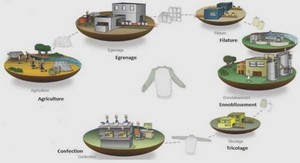Structure du paysage et fonctionnement hydrologique
Study area
General description
The study area is the cultivated portion of the Hérault French département of the LanguedocRoussillon région, in the south of France. We did not consider the northern mountainous region, where cultivation is limited, or the eastern part, where urbanization is high (Fig.3.2). At the département scale, the land-cover is mainly vineyards, comprising 50 % of the utilized agricultural area. However, a third of the vineyards have been grubbed up for twenty years because of the wine crisis (DDTM34, 2011). Nearly 10 % of the utilized agricultural area is planted with cereal fields. In the southern and western cultivated areas of the département that we studied, the proportion of vineyards is even higher (approximately 75 %). In 2000, small farms predominated with an average farm area of 13 ha according to the data from the agricultural census conducted by the Regional Direction of Agriculture and Forest. The climate is Mediterranean with 600 mm to 800 mm of precipitation per year and two short but intense rainy seasons in the autumn and spring. This climate combined with the intensive vine cultivation, causes the area to be sensitive to flash flooding, erosion and pesticide contamination. For example, the mean erosion rate in the study area is 10.5 t ha−1 year −1 but the spatial variability of the intensity of erosion is high (Paroissien et al., 2010). The altitude varies between approximately 0 m and 350 m in the southern portion of the département. From a geomorphologicaly point of view, we can distinguish four main areas: (i) the alluvial and coastal plains and low terraces of the main rivers, (ii) the hilly landscapes that are mostly calcareous but also contain marls, (iii) the hilly landscapes on shales in the western portion of the area and (iv) the mountains in the northern part of the département (outside of our study area). Two main catchments cover our study area, the catchments of the Hérault and Orb rivers. The ten survey areas are distributed through the vineyards area of the Hérault département and the three main cultivated pedo-landscapes.
Field data Spatial sampling of contrasting landscapes located in the study area
All of the man-made drainage networks throughout the entire study area could not be surveyed in the field. Thus, a stratified sampling strategy based on landscape characteristics was performed. The landscape characteristics used to define the sampling strategy were the pedo-landscapes given by soil map 2 (Table 3.3), the main type of land-cover and the topography (Fig.3.2). All of these characteristics were assumed to have an influence on the man-made drainage density of the landscape. Consequently, nine 1 km2 square areas and one larger area (40 km2 ) were selected (Table 3.1) for exhaustive field surveys. The goal of selecting the large survey area (the Peyne subcatchment) was to allow us to analyze the spatial variability of drainage densities for multiple geographical supports. Data acquisition In contrast to natural stream networks, man-made drainage networks are almost never mapped on topographical maps. Their remote sensing is not yet accurate enough to create such maps 55 tel-00745506, version 1 – 25 Oct 2012 Chapitre 3 : Modélisation spatiale de la densité des réseaux de fossés dans les paysages cultivés Table 3.1: Survey areas characteristics Survey area name Size Pedo-landscape Land-cover 1 – Saint-Jean-de-Fos 1 km2 Fluvial terrace, flat area Vineyards / orchards 2 – Canet 1 km2 Fluvial terrace, very flat area Vineyards 3 – Le Pouget 1 km2 Plateaux, former pond drained by ditches Vineyards 4 – Saint-Pons-de-Mauchiens 1 km2 Hills Vineyards, shrubs 5 – Montagnac 1 km2 Hills Vineyards 6 – Saint-Thibéry 1 km2 Alluvial plain, flat area Vineyards 7 – Bessan 1 km2 Plateaux, upslope position Vineyards 8 – Béziers 1 km2 Plains and hills Cereal fields 9 – Caussiniojouls 1 km2 Hills on shales Vineyards 10 – Peyne subcatchment 40 km2 Plains and hills Vineyards, cereal fields, shrubs (Bailly et al., 2008). Indeed, man-made drainage ditches may be very narrow (widths and depths of less than 1 m) and densely covered with vegetation. Moreover, only features with horizontal dimensions of the same order of magnitude as the ground resolution of remotely sensed data can be detected (Notebaert et al., 2009). This limits the usability of remote sensing at a regional scale because very high resolution data are not available at this scale (Notebaert et al., 2009). Therefore, drainage density cannot be accurately inferred from the delineations provided by geodatabases or remote sensing data. We thus conducted field surveys of these man-made drainage networks in the spring and summer of 2010 at an average speed of 1.5 to 3 km2 per day and per person according to the difficulty of the terrain. The man-made drainage networks mainly consisted of agricultural ditches, roadside ditches, culverts, canalized streams and sunken paths and roads. The width and depth of these elements varied from approximately 50 cm to several meters. 50 cm aerial photographs were used at a scale of 1:5,000 to locate the elements of the drainage networks in the fields. The man-made drainage networks were then digitalized and georeferenced using the Quantum GIS (QGIS) software (Quantum GIS Development Team, 2011).
Methods
The methodology of the proposed modeling process includes four steps: 1. the selection of a geographical support to model the drainage density; 2. the selection and calibration of a spatial explanatory model; 3. the identification of the potential landscape explanatory variables of the man-made drainage density; 4. the assessment of the performance of the explanatory model. 56 tel-00745506, version 1 – 25 Oct 2012
Selecting a geographical support
Square grid-based analysis To model the drainage density, we used a square grid for which the cumulated length of the drainage network divided by the grid cell area was attributed to each grid cell. A grid-based analysis was used for various reasons. Square grids allowed us to model the drainage density throughout the landscape with the same geographical support. This would not be possible if either individual drainage features (e.g., a ditch) or catchments were used as the spatial scale of the analysis. Moreover, a square grid-based analysis allowed us to link the spatial variability of the drainage density with landscape explanatory variables. We could have used kernel estimators instead, but we chose a square grid-based analysis because of its simplicity and the absence of edge effects. Furthermore, the use of a square grid allowed us to maintain the maximal spatial variability of the drainage densities. For all of these reasons, grid-based analyses have been used in various studies to compute the densities of linear elements of landscapes, such as streams (Oguchi, 1997; Luoto, 2007), hedgerows (Burel and Baudry, 1990; Deckers et al., 2005), roads (Hawbaker et al., 2005) or lineaments (Casas et al., 2000). Nevertheless, the use of a square grid creates an issue with the selection of the grid cell size Borruso (2003). To deal with this issue, we proposed a method to define empirically the optimal grid cell size in our study Selection of the grid cell size for the spatial modeling of man-made drainage density Numerous studies have dealt with the selection of the grid cell size (Obeysekera and Rutchey, 1997; Hengl, 2006; Duveiller and Defourny, 2010). However, none of these studies have considered the case of making density maps from maps of linear features, though these studies have considered the use of different criteria to optimize the cell resolution (e.g., object detection in images). Moreover, all of these studies dealt with the case of a variable fully defined in space, such as elevation or land-cover. In studies concerned with the densities of linear features, the selection of the scale was often arbitrary (Hawbaker et al., 2005) or related to farms or fields characteristics (Burel and Baudry, 1990; Deckers et al., 2005). Nevertheless Casas et al. (2000) suggested that the best choice of grid cell size to study the densities of lineaments would be the one that respected the average spacing between the lineament under examination. Using a grid that respects the line spacing allows for the minimization of the number of cells that do not contain any lines. To take into account the line spacing, we proposed to directly determine the grid cell size for which no bi-modality in the distribution of the resulting drainage densities was observed. The test for unimodality was performed using the dip-test (Hartigan and Hartigan, 1985) in the GNU-R software (R Development Core Team, 2010). The dip statistics were computed for the drainage density distributions from the samples with grid cell sizes of 50 m, 100 m, 166 m, 200 m, 250 m, 333 m, 500 m and 1000 m; each value is approximately a divisor of the size of most of the survey areas (1000 m × 1000 m). The values of the dip statistics were then compared with the values of the dip statistic for 100,000 uniform distributions. We could reject the null 57 tel-00745506, version 1 – 25 Oct 2012 Chapitre 3 : Modélisation spatiale de la densité des réseaux de fossés dans les paysages cultivés hypothesis of uni-modality with an error probability of less than 1% (arbitrary threshold) if the dip statistic for the tested sample was higher than the 99-th quantile of the distribution of the dip statistics for the uniform distribution. However, we searched for a coefficient of variation of drainage densities that remained high because we also wanted to maintain a high variability of drainage densities. The best cell size for this study should therefore be a compromise between the line spacing and the variability of the resulting drainage densities.
Spatial explanatory model of man-made drainage density
To select a spatial explanatory model, Hengl (2009) proposed a general decision tree. Using this framework, we chose a regression-kriging model. Regression-kriging combines a regression of the dependent variable on the auxiliary variables with the simple kriging of the regression residuals (residual kriging). This method allows the user to separately interpret the power of the regression model, the deterministic part, and that of the kriging interpolation, the stochastic part, i.e., the non explained part of the variability (Hengl et al., 2007). An advantage is thus to measure the spatial correlation in randomness that can drive to consider other processes. Hence, this method has been used in many studies because of its simplicity and its ability to consider both a deterministic component and a spatial dependence structure to model a variable, e.g., for the prediction of meteorological data (Alsamamra et al., 2009) or soils properties (Hengl et al., 2007). For the regression model, we chose a multiple linear regression (MLR) model. From the residuals of the MLR model, we computed an empirical semivariogram (Matheron, 1962), which plots the semivariance, i.e., the expected squared increment of the residuals distant from a given distance h against the distance h. From the empirical semivariogram, a semivariogram was modeled and used for the modeling of the residuals in the unsampled areas by kriging interpolation. Thus, the target variable, i.e., the drainage density, could be expressed for an unsampled location s0 as the sum of the deterministic and stochastic components Hengl (2009): zˆ(s0) = ˆm(s0) + ˆe(s0) (3.1) zˆ(s0) = X p k=0 βˆ k × qk(s0) + Xn i=1 λi × e(si) (3.2) where ˆm(s0) = Pp k=0 βˆ k ×qk(s0) is the fitted deterministic component, i.e., the MLR model; eˆ(s0) = Pn i=1 λi × e(si) is the interpolated residual; p is the number of explanatory variables of the MLR model; n is the number of observations; βˆ k are the estimated MLR model coefficients (βˆ 0 is the estimated intercept); qk(s0) are the values of the explanatory variables at location s0; λi are the kriging weights depending on the spatial dependence structure of the MLR residuals and e(si) is the residual at location si . The MLR coefficients βˆ k were estimated from the training sample by the ordinary least squares (OLS) method. We used the geoR library in the GNU-R software to perform the regression-kriging.
Identification of potential explanatory variables of man-made drainage densities
To identify potential explanatory variables of man-made drainage densities relative to landscape attributes, we considered the role of these man-made drainage networks. According to the literature, the roles of man-made drainage networks are the interception of runoff from hillslopes and roads, the lowering of the water table via the drainage of groundwater and the conveyance of water towards downstream areas (Dunn and Mackay, 1996; Ramos and Porta, 1997; Adamiade, 2004; Carluer and Marsily, 2004; Duke et al., 2006). We first considered the influence of topography on runoff production and accumulation. We computed two topographic indices: the convergence index with a search radius of 250 m (Kothe and Lehmeier, 1996) and the slope derived from the 5 m DTM (Table 3.3). They were both computed using SAGA GIS (http://saga-gis.org). Low values of the convergence index corresponded to areas where water converges; thus high convergence index values were assumed to indicate a low drainage density. The type of soil in an area affects the runoff production and the possibility of waterlogging. Hence, we classified the different soil units based on three characteristics. Type 1 soils limited the production of runoff and were thus assumed to disfavor high man-made drainage densities. Type 2 soils favored waterlogging and were thus assumed to favor high man-made drainage densities. Type 3 soils had no particular impact on runoff and were assumed to be neutral concerning their impact on man-made drainage density. Many parameters control the soil infiltration capacity (Wassenaar et al., 2005; Paré, 2011) and consequently the production of Hortonian runoff which is the prevalent runoff in Mediterranean areas. The effect of soil tillage or the amount of grass cover, for instance, can be very important in reducing runoff, but these factors are not constant in time and thus not easy enough to map to be considered here. However, the presence of stones on the surface was also recognized as a key parameter that can increase the soil infiltration capacity (Poesen et al., 1990; Wassenaar et al., 2005). In our study, the soils with numerous and not embedded stones on the surface were thus classified as type 1 soils. For instance, the soils of the Bessan survey area were considered to be type 1 soils. Concerning waterlogging, the soils that had a deep heavy, horizon were classified as type 2 soils; the best example of this was the soils of the survey area of Montagnac. All the other types of soils were classified as type 3. Thus, the two explanatory variables selected concerning soil type were the percentage of type 1 soils and the percentage of type 2 soils within a grid cell. To take into account the impacts of roadside ditches, two explanatory variables were chosen: the density of the main and secondary roads (d.roads.1) considered to be regularly maintained on the Institut Géographique National (IGN) maps (Table 3.3) and the density of other roads (d.roads.2) also considered to be regularly maintained. The roads were digitized on the maps of the landscapes structural elements (Table 3.3). The density of field unit boundaries was added as another possible explanatory variable of man-made drainage density. Agricultural ditches were the most frequent features of these 5 Chapitre 3 : Modélisation spatiale de la densité des réseaux de fossés dans les paysages cultivés networks and were always located along field unit boundaries. For instance, we surveyed a few agricultural ditches in the Béziers area which is covered by large cereal fields. Natural areas were not considered in our study, although they certainly decreased surface runoff. First, few natural areas were present in our survey areas (except in Saint-Pons-deMauchiens). Secondly, when a large patch of natural area was present, the density of the field unit boundaries accounted for the expected effect of the decreased drainage density caused by the presence of natural areas because we only considered boundaries of cultivated field units. Finally, we included seven potential explanatory variable relative to landscapes attributes to model man-made drainage density, all represented by quantitative variables (Table 3.2). These explanatory variables may be considered orthogonal (maximum coefficient of correlation ρ=0.25). We gathered various maps (Table 3.3) to compute these variables. Two soil maps were needed because the most detailed soil map did not cover the entire study area.
Introduction générale – Positionnement scientifique |




